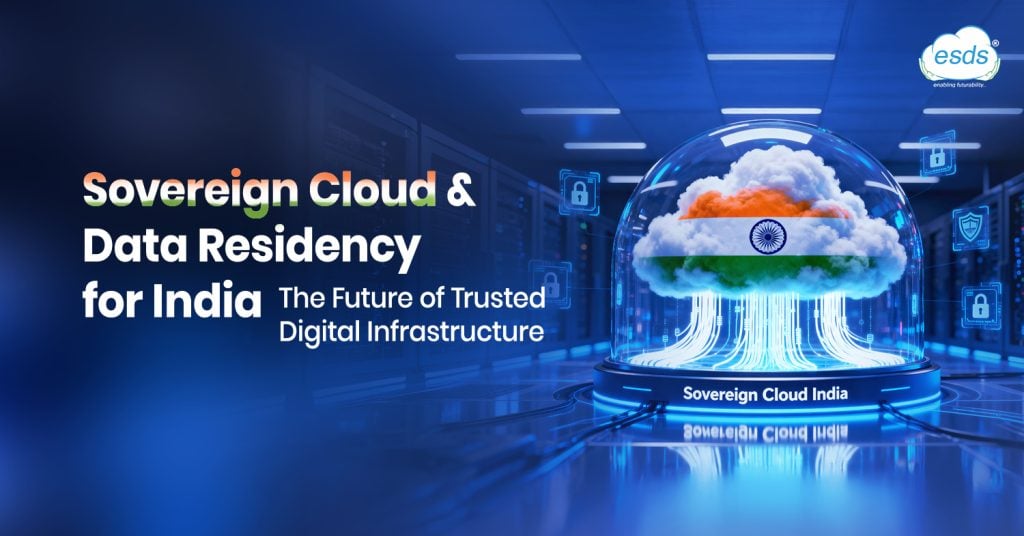Sovereign Cloud & Data Residency for India: The Future of Trusted Digital Infrastructure

How Indian enterprises can balance compliance, control, and innovation in the cloud era.
Introduction
India’s digital economy is accelerating faster than ever, but with that growth comes a pressing question: where does your data truly live—and who governs it?
As India enforces the Digital Personal Data Protection Act (DPDP), 2023, and introduces supporting rules, data sovereignty and residency have moved from compliance checkboxes to strategic imperatives. For businesses, government entities, and regulated sectors, the sovereign cloud represents not just legal compliance but also control, resilience, and trust.
1. What Is a Sovereign Cloud?
A sovereign cloud is a cloud infrastructure designed so that data, metadata, and administrative control remain within a country’s jurisdiction and are protected by its laws.
While data residency ensures that data is stored on servers physically located in India, data sovereignty goes further — adding layers of legal, operational, and technical safeguards to guarantee that no foreign entity can access or process Indian data without consent.
2. India’s Legal Landscape: DPDP Act and Draft Rules
The Digital Personal Data Protection Act (DPDP), enacted in 2023, is India’s first dedicated personal-data law. It sets the foundation for how personal data can be collected, processed, and transferred.
In January 2025, the Ministry of Electronics & IT (MeitY) released the Draft DPDP Rules for consultation, which aim to clarify cross-border data transfer norms, obligations for data fiduciaries, and storage requirements. Once finalized, these rules will operationalize India’s data-sovereignty regime and impact every organization that handles citizen data.
✅ Key takeaway: Start aligning infrastructure and processes now — once rules are notified, compliance timelines could be short.
3. India’s Sovereign-Cloud Ecosystem
India’s government and private sectors are building a layered sovereign-cloud ecosystem:
- Government Initiatives: Projects like MeghRaj (GI-Cloud) and NIC Cloud deliver secure infrastructure for e-governance and national digital services.
- Industry Offerings: Leading global providers have introduced India-specific sovereign or multi-zone regions, designed to keep data, encryption keys, and admin operations local.
- Domestic Partnerships: Telecom and IT giants are partnering to launch sovereign-grade private clouds that combine regulatory compliance with hyperscale agility.
Together, these developments are creating a trusted digital foundation for India’s trillion-dollar digital-economy vision.
4. Why Sovereignty Matters for Businesses
Advantages
- Regulatory Confidence: Seamless alignment with DPDP, RBI, IRDAI, and healthcare data-governance frameworks.
- Operational Control: Local data management and quick incident response under Indian law.
- Reduced Risk: Protection from foreign subpoenas or extraterritorial access.
- Customer Trust: Demonstrable commitment to privacy and national compliance.
Trade-offs
- Higher infrastructure costs for isolated regions.
- Potential lag in advanced managed services.
- Additional governance complexity in hybrid environments.
5. Technical Blueprints for Compliance
Organizations can choose from multiple deployment models:
| Approach | Description | Best For |
| India Region (Residency) | Data stored in India-based public-cloud zones | Low-risk workloads |
| Sovereign Region / MZR | Isolated cloud region with local key management & restricted admin access | BFSI, government, healthcare |
| Private or On-Prem Cloud | Dedicated hardware hosted in India | High-sensitivity data |
| Air-Gapped Infrastructure | Fully disconnected systems | Defense, national security |
| Hybrid Sovereign Model | Sensitive workloads local; analytics on global cloud | Most enterprises |
Technical essentials: encryption at rest & in transit, customer-managed keys (CMKs) stored in India, granular IAM, and continuous compliance monitoring.
6. Compliance Roadmap for Indian Enterprises
- Classify and map data flows — know what data you process, and where.
- Define residency policies for each data category.
- Implement encryption and local key control.
- Build hybrid architectures for flexibility and compliance.
- Update contracts and SLAs with vendors to ensure jurisdictional control.
- Train teams and test incident response regularly.
- Stay adaptive — DPDP rules and sectoral guidelines are still evolving.
7. The Road Ahead
India’s sovereign-cloud landscape will evolve rapidly as:
- Final DPDP Rules come into force.
- Cloud providers expand sovereign and air-gapped offerings.
- Local hyperscalers gain government empanelment for public-sector workloads.
Forward-thinking organizations will blend innovation and compliance — using hybrid-sovereign architectures to unlock agility while preserving national control.
Conclusion
Sovereign cloud and data residency are no longer niche regulatory concerns — they are core pillars of enterprise resilience and digital trust.
By embracing India’s sovereignty-first framework today, organizations not only meet compliance standards but also future-proof their operations for a secure, connected, and globally respected digital economy.
